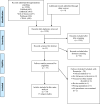Depression and Anxiety Among Arab Individuals in the United States: A Meta-analysis
- PMID: 39602001
- PMCID: PMC11903594
- DOI: 10.1007/s10903-024-01648-9
Depression and Anxiety Among Arab Individuals in the United States: A Meta-analysis
Erratum in
-
Correction: Depression and Anxiety among Arab Individuals in the United States: A Meta-analysis.J Immigr Minor Health. 2025 Apr;27(2):351-365. doi: 10.1007/s10903-024-01665-8. J Immigr Minor Health. 2025. PMID: 39833427 Free PMC article. No abstract available.
Abstract
Emerging research suggests that the increasing population of Arab immigrants and refugees living in the United States (U.S.) has a greater risk for depression and anxiety than other groups. The purpose of this meta-analysis was to estimate the prevalence of depression and anxiety for Arabs in the U.S., to examine the moderating effects of key demographic variables (gender, immigration status, ethnicity) and study characteristics (research design and quality) on the prevalence of anxiety and depression, and to evaluate the direct effects of additional demographic and study characteristics on prevalence rates. Using guidelines from the Preferred Reporting Items for Systematic Review and Meta-Analysis Protocols (PRISMA-P), we searched PubMed, Embase, CINHAL, ProQuest, and the Web of Science databases for articles published between January 2000 and March 2023. Two reviewers each individually extracted the articles' data and evaluated the reported study's methodological quality using a well-established checklist. Statistical analyses consisted of random effects models to estimate the pooled prevalence of depression and anxiety across all studies, separate random effects models for distinct demographic (e.g., immigration status) and methodologic (e.g., study quality) subgroups that might have unique prevalence rates, and a meta-regression to identify additional variables (e.g., age of individuals) that might influence prevalence rates. Our review included 17 studies with a total sample population size of 22, 558 participants. Results indicated that the estimated prevalence of depression overall was 48% (CI 34, 63%) and 58% (CI 33, 83%) for the prevalence of anxiety. Our subgroup analyses uncovered notable variations in prevalence rates based on gender composition, immigration status, ethnicity, and research quality while results of the meta-regressions demonstrated effects of publication year and age of the Arab individual on the estimated prevalence of depression and anxiety. The high prevalence rates for depression and anxiety identified through this meta-analysis are very concerning and underscore the urgent need to address mental health concerns in Arab communities. Results of subgroup and meta-regression analyses suggest that refugees, individuals from specific countries of origin, and younger Arabic persons may need particular attention by clinicians in screening for and treating their depression and anxiety. Our results also signify the need for further high-quality studies to more rigorously assess prevalence of these mental health problems, since we found evidence of potential publication bias and approximately one third of the studies in the review had less optimal methodological quality based on our evaluation. Ultimately, in-depth research regarding the causes of anxiety or depression among Arab individuals will be essential to the development of culturally competent interventions that may reduce their very high prevalence rates.
Keywords: Anxiety; Arab; Depression; Immigrants; Refugees.
© 2024. The Author(s).
Conflict of interest statement
Declarations. Conflict of interest: The authors declare that they have no conflict of interest. Ethical Approval: We used published data and do not include human subjects.
Figures
References
-
- Shafeek Amin N, Driver N. Sex differences, duration of stay in the United States, and serious psychological distress: the case of Middle Eastern immigrants in the United States. Fam Community Health. 2019;42(2):90–103. 10.1097/FCH.0000000000000217. - PubMed
-
- Alkaid Albqoor M, Chen JL, Weiss S, Waters C, Choi JW. Serious psychological distress: a national study of Middle Eastern immigrants. J Psychiatric Mental Health Nursing. 2021;28(2):163–73. 10.1111/jpm.12646. - PubMed
-
- Wrobel NH, Farrag MF, Hymes RW. Acculturative stress and depression in an elderly Arabic sample. J Cross Cult Gerontol. 2009;24(3):273–90. 10.1007/s10823-009-9096-8. - PubMed
Publication types
MeSH terms
LinkOut - more resources
Full Text Sources
Medical





